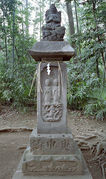Glossar:Dousojin: Unterschied zwischen den Versionen
Zur Navigation springen
Zur Suche springen
K |
K |
||
| Zeile 2: | Zeile 2: | ||
kanji=道祖神| | kanji=道祖神| | ||
romaji=''dōsojin''| | romaji=''dōsojin''| | ||
| − | text=Wegegott, auch ''sae no kami'' | + | text=Wegegott, auch ''sae no kami''; volksrel. Figuren, manchmal in phallischer Form| |
stichwort ={{{1|}}}| | stichwort ={{{1|}}}| | ||
link={{{2|Alltag:Matsuri/Phalluskulte}}}| | link={{{2|Alltag:Matsuri/Phalluskulte}}}| | ||
| − | tags= | + | tags= kami, phallus, volksreligion |
}} | }} | ||
Version vom 18. Mai 2011, 14:37 Uhr
dōsojin 道祖神 (jap.)
Wegegott, auch sae no kami; volksrel. Figuren, manchmal in phallischer Form
Der Begriff „dōsojin“ wird in diesem Handbuch auf folgenden Seiten erwähnt:
- Torii: Markenzeichen der kami (Kapitel „Bauten“)
- Phallus-Kulte: Fruchtbarkeitsriten, Volksbräuche und shunga (Kapitel „Alltag“)
- Tengu: Japanische Vogelmenschen (Kapitel „Mythen“)
- Affen, Würmer und durchwachte Nächte (Kapitel „Mythen“)
Bilder

